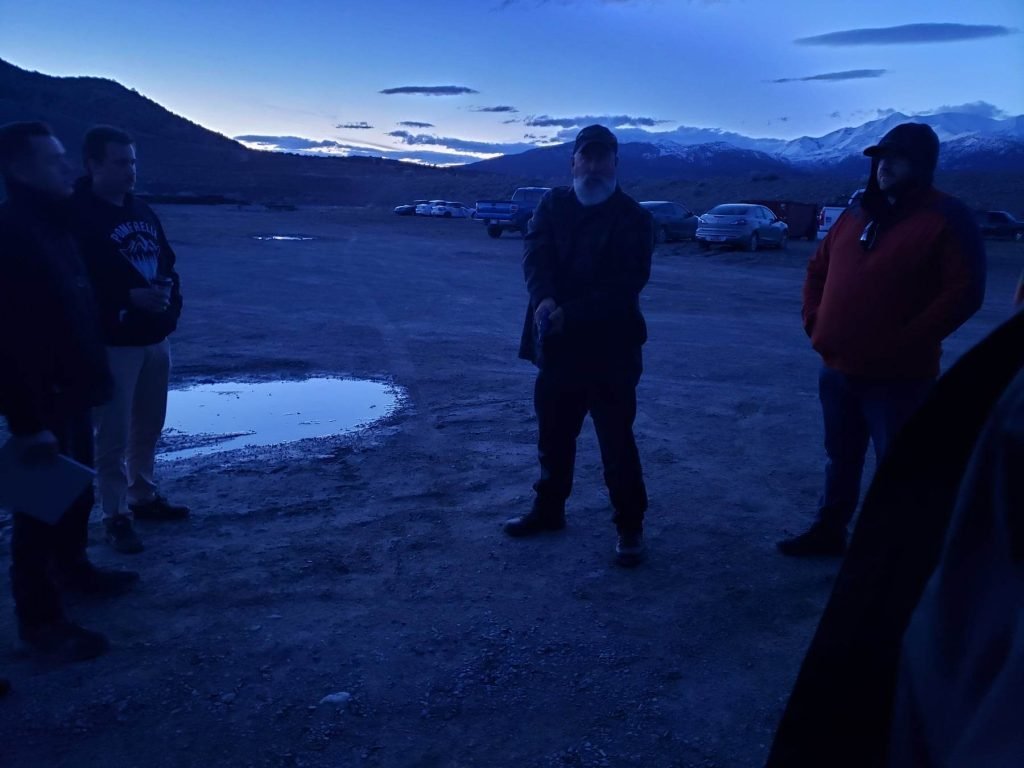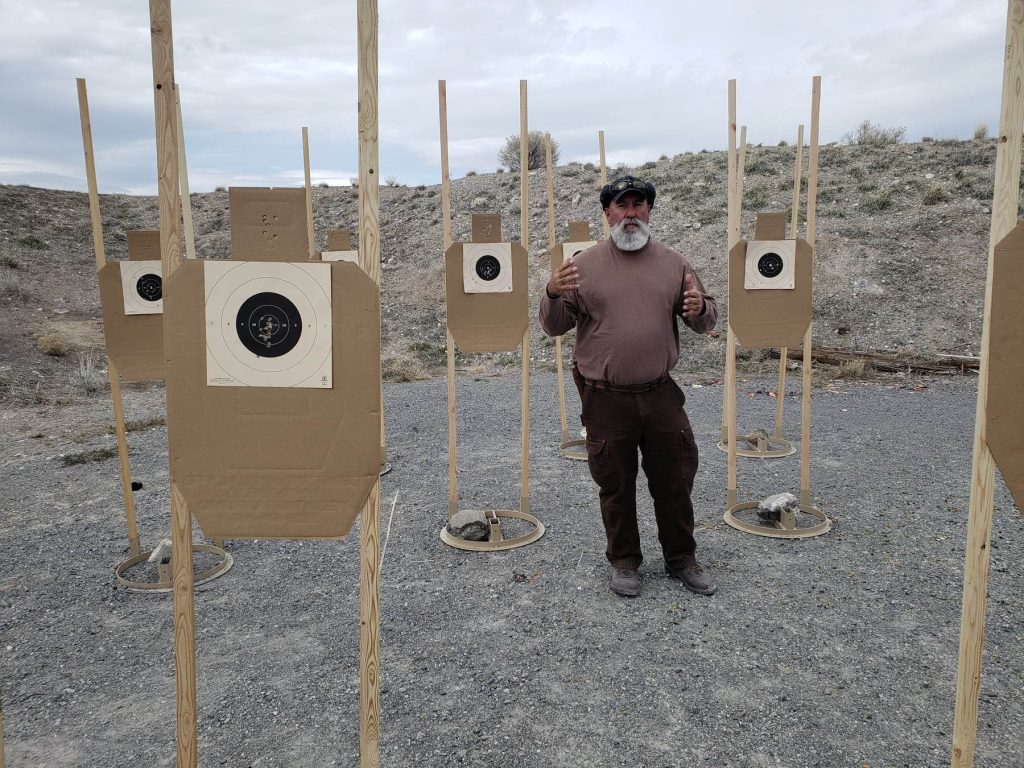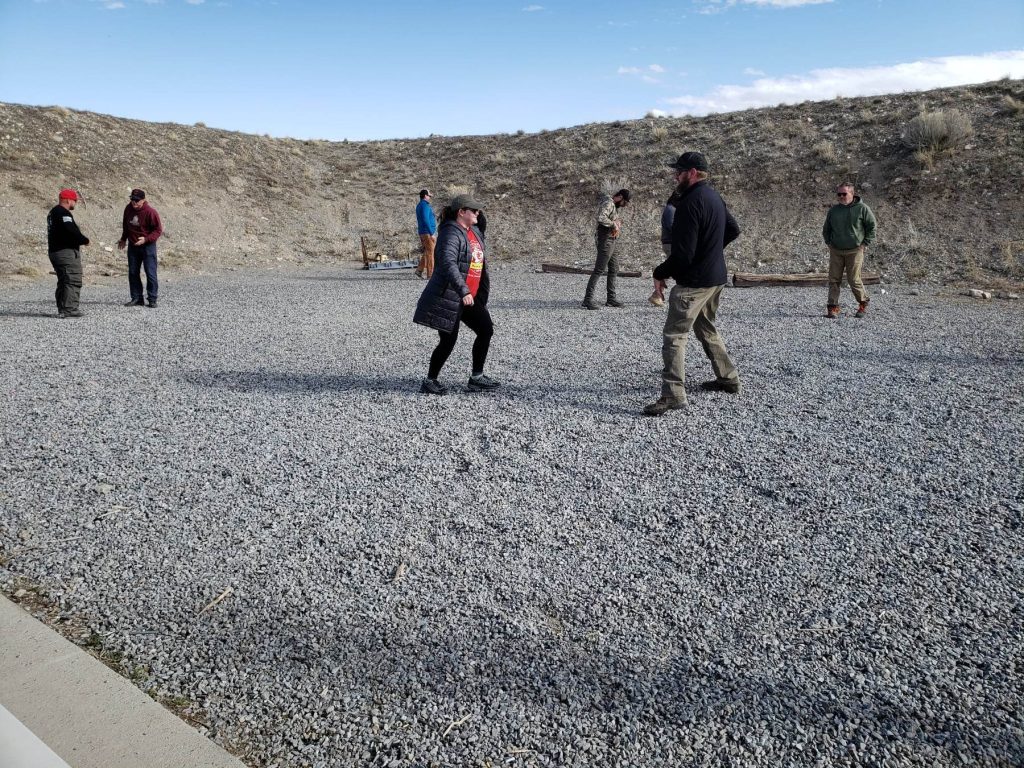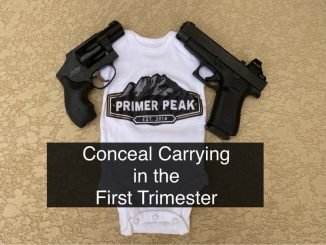
Shooting courses are a lot like other hobbies. People like to practice what they’re good at, and often avoid anything that’s a real challenge. Something flashy, tangible, or cool drives people to sign up, trying to improve their scores by fractions of a second or earn a trinket for performance. NPE/Counter Robbery is not one of those courses.
During this 2-1/2 day course, you’ll learn about conceal carry in non-permissive environments, as well as skills to help you avoid or navigate violent encounters. With three incredible instructors in Darryl Bolke, Cecil Burch, and Chuck Haggard, students learn marksmanship, less lethal tool employment, and empty handed skills to succeed in the real world.
Location
The Farm Training Center, Fairfield, Utah
Weather
During class the weather ranged from cool to cold, with winds changing from a slight breeze to brief gusts. Most days were sunny, and overall pleasant, if a little chilly.
Equipment for NPE / Counter Robbery
During class I shot my Smith & Wesson 640 Pro, outfitted with Crimson Trace LG-305 grips, carried in a JM Custom Kydex AIWB1 holster. I kept the gun fed with SL Variant loaders carried in Speedbeez pouches, Bianchi speed strips, and a Galco 2x2x2 pouch. For MUC portions of class I carried a Ring’s J-Frame blue gun in a Harry’s Holsters Icon 2.0. Throughout class I kept my S&W 351C in a Galco Ankle Glove, though I did not end up using this in live fire.
Personnel
We started with 19x students in class, 2x women and 17x men. One male did not return to class after the first day, with no explanation. Students range from real estate agents, to unemployed, former military, and more.
Equipment varied fairly widely, with some shooters using nearly USPSA-esque equipment, to others running J-Frames of various calibers, S&W Shields, and more. The largest guns that I noticed were a Glock 48, and HK P30SK, though I believe there were one or two full size pistols present. Most shooters carried AIWB, though some opted for pocket carry. Our own Ally Corless planned to use her Flashbang, though the cold weather prevented its use.
Day One of NPE / Counter Robbery
The first day of NPE/Counter Robbery is a partial day, beginning at 6PM. Darryl Bolke, Cecil Burch, and Chuck Haggard give us their introductions, and provide an overview of the next two days. They describe the course as a vehicle in which to think; an application of force class in a consequence free learning environment. NPE/Counter Robbery is not a shooting class, but rather a class on how to avoid shooting someone.

Safety is a big focus, as is the standard for these instructors. The Combat Triad, as devised by Colonel Cooper is covered, along with what goes into the moral, ethical, and legal use of force. These are topics that will be heavily focused on during class. We are here to learn how things work in the real world, not to burn down targets and win trinkets.
The evening closes with Darryl demonstrating various ready positions using a blue gun. These include ways to quickly maneuver around non-threats in public. With the sunlight rapidly fading, we conclude training for the night.
Day Two of NPE / Counter Robbery
We begin day two of NPE/Counter Robbery by noticing we are one student short. This student never returns, nor provides any explanation to the instructors as to why he left. After this, class is broken into two relays. One group heads to the range with Chuck and Darryl. My groups stays in the classroom with Cecil.
Managing Unknown Contacts with Cecil Burch
Cecil begins with lecture. He tells us how the normal range provides us virtually no ambiguity, the total opposite of the real world. Bad guys can look like anything, and any biases we hold are not the totality of experiences or circumstances. As good guys, we cannot treat everyone we come across as hostile, nor is everyone necessarily benign. This sounds complicated, but we will be given tools throughout the weekend to navigate the uncertainties of life.
Heading Outside
After a lecture on awareness, my group heads outside to our training area. Students doff their weapons in a secure place, and are checked by each other and the instructor to ensure things are safe.

Cecil starts with the basics of arcing movement to help create distance and improve our position. We practice this with partners, and some find themselves struggling to stay on their feet. Next, Cecil gives us the fence, keeping our hands up to protect ourselves while also providing access to tools. From here we work on the beginnings of verbal commands, then combine the three in 1v1 partners exercises.
Soon it is time to swap places with the other group. We pack our things and head down to the range.
Range Time with Darryl and Chuck
Upon arrival to the range, we cover safety again before getting guns out. Targets are a mix of B8 Repair Centers and USPSA silhouettes. We work the HiTS Standards Warmup, shooting at 3, 5, and 7 yards. Things start at low ready, then we move to drawing from the holster. Shots are a mix of body and headshots on the silhouette. The range is well controlled, and Darryl provides time for those using pocket holsters to safely get the guns back in place before proceeding.

Once we wrap up the morning’s shooting, we get a brief lecture on the range. We cover post-fight prep, with considerations made for topping off the gun, along with 911 procedures to help ensure our safety after the fight. From here we break for lunch.
Less Lethal Lecture and Demo with Chuck Haggard
If you’ve taken any of Chuck’s less lethal coursework, then this will sound a little familiar. That wasn’t the majority case here, so most students were in for a treat. Chuck begins by talking about the use of force with impact weapons versus pepper spray, and the importance of having “something between a harsh word and a gun.” We cover differences in formulas and how to measure the potency of pepper spray, along with different forms of spray, and more.

After the lecture concludes, class heads outside to the training area where Chuck provides inert units of POM pepper spray to everyone. From here, we each get to practice accessing our spray, and using IT against one another in a controlled environment. This is paired with verbal commands, along with the fence technique taught earlier in the day.
Chuck wraps up his demo and we break back into our two groups to continue the day.
Managing Unknown Contacts with Cecil
After a quick refresher of the morning, Cecil dives deeper into verbal commands. He stresses the importance of volume, tone, and language to stop encroachment without causing an escalation. As part of this, we discuss profanity–how and when to use it, and how your ability to be genuine can drastically alter results.

Cecil reminds us that not everyone is a threat. We must vary our tactics based upon the reactions we receive to enforcing our boundaries. This leads into discussion on pre-assault indicators with demonstrations from Cecil, then practice from us. In summary, we must evaluate our situation based upon context, and the totality of our circumstances. We cannot have our fangs out in public just because there are unknowns.
Afternoon Range Time with Darryl Bolke and Chuck Haggard
Upon arrival to the range, we are immediately presented with a more complex scenario than the morning gave us. With three layers of targets, we have a mix of threats and innocent bystanders. Consider this a No-Muzzle El Presidente of sorts. We are able to move laterally, but must account for shoot-throughs, while also maintaining muzzle awareness of non-threats.

Shooters solve this issue in a variety of ways, with some being more or less optimal. Each student gets a brief debrief of their results, and then we rearrange targets for the next shooter. Darryl reminds us that this is simply the square range. Our scenarios do not account for movement of those down range, and that riskier shots may result in a negative outcome.
Brief Lecture on the Range
Once everyone has completed their shooting, Chuck and Darryl give us a quick lecture. The topic is speed strips. We cover different brands, with pros and cons of each, to include considerations for calibers other than 38/357. Both of them give their preferences for setting up rounds, then demo their techniques for class. Afterwards several students can be seen rearranging their ammunition to try things for themselves.
Day Three of NPE / Counter Robbery
Day three begins much like the previous day. We break into our same smaller groups, then head out to our assigned instructors. This time Chuck Haggard stays up near the classroom to partner with Cecil Burch, while Darryl stays on the live-fire range.
Managing Unknown Contacts Lecture with Chuck Haggard
Context, awareness, and action are the focuses of Chuck’s lecture. As we move in and out of higher danger areas, our awareness must fluctuate to meet demand. Transitional spaces like parking lots, and high traffic areas like gas stations require more focus than somewhere like the library.

Chuck tells us to listen to our instincts during the pre-MUC phase, trying to avoid confrontations in the first place. “If that shit don’t look right, that shit ain’t right” is our mantra. Don’t let normalcy bias take hold, and don’t feel obligated to meet all social graces.
MUC Exercises with Cecil
Continuing from Chuck’s lecture, Cecil reminds us that we have a continuum of options regarding force. While the gun is there, it acts as a parachute or seatbelt once all other options have failed us. We are attempting to reduce encroachment with causing escalation, while being prepared for suboptimal results. This leads to discussion on proactive and reaction weapon access, and their pros and cons.
Our ability to control space and maintain a position of advantage will partially dictate this access. Cecil asks us to consider “how far is too close?” regarding our distance to a potential threat. Answers vary greatly, and quickly change when we see how far someone can reach from a standing lunge, all without warning.
Heading Outside
We move to the outdoor training area to begin working our MUC skills with our newly acquired inert OC spray. We cover access to the tool, employment, and integrate previous lessons on movement, verbal commands, and more. To close things out, Cecil reminds us to plan for post-deployment of OC. Context will change this greatly.

Maybe we attempt to escape, move to cover, transition to another level of force, or something entirely different. None of these tools are magic talismans, so we must prepare to act.
On the Range with Darryl Bolke Chuck Haggard
Back on the range, Darryl and Chuck have devised another drill, referred to as the “Blue Tape Drill”. As before, we have a mixture of threats, unknowns, and innocents. Among the threats, some require force but haven’t met the requirements for lethal force. Others need varying numbers of rounds before neutralization, while others need hits in specific places. All of this is indicated by different markings on the target, often with the use of blue tape, hence the name.

Some shooters struggle greatly with this, hosing targets down like a USPSA stage. Others move slowly, increasing their exposure to danger while navigating the somewhat complex directions of the drill. After each shooter, students rearrange targets for new angles, differing levels of danger, and more.
Instructor NPE Gear Show and Tell
After lunch, we reconvene for a casual discussion from the instructors. This is where the “non-permissive environments” aspect comes into play, in my opinion. Darryl covers different levels of concealment, using his “covered, concealed, undetectable” tiers to explain both visual and physical aspects.
Each instructor gives their personal carry setups for different scenarios they find themselves in. This covers a variety of carry methods, such as ankle, pocket, and deep concealment, along with different tool selection. Choices range from something like a P365XL, to a S&W 351C, or simply OC or impact weapons. Travel to states and facilities with strict laws are covered, with varying levels of risk significantly impacting these decisions.
Students get the opportunity to handle different pieces of gear, and ask questions. After the lecture concludes, we once again break into our groups for the afternoon session.
Managing Unknown Contacts with Cecil Burch
The afternoon begins with a refresher of the lunge from a threat, having us work that against our arcing movement. From here we incorporate blue guns, and work different parts of the presentation on target. Threats are encouraged to attempt a gun grab to help reinforce timing errors on the part of the defenders.

Next we learn about the eye jab. This is a quick strike, causing no serious or permanent injury to our unknown contact. It offers us a brief moment to gain a position of advantage, or prepare to employ other tools. We work this using our outstretched hand or chest as a target to help safeguard our eyes. Despite this, an overenthusiastic partner still manages to land a legitimate eye jab on me. Luckily we are all wearing our eye protection, so I walk away no worse for wear.
With all of these tools available to us, we work our MUC exercises in totality. This means arcing movement, verbal commands, eye jabs, OC, blue guns, and more. Everyone swaps partners intermittently, and gets time as both the unknown contact and the defender. As with the rest of the weekend’s training, Cecil keeps a close eye on everything, providing feedback as necessary. Once this wraps up, we head back to the range for our final block of the day.
Range Time with Darryl Bolke and Chuck Haggard
We arrive on the range to a briefing from Darryl. Each of us will individually run through an additional “blue tape” drill, but this time we go in totally blind. Students are sent up range, facing away from the targets. One by one we are brought down, led backwards towards the target area. On the command, we are let loose to see the stage, evaluate it for potential action, and eliminate threats if necessary. Some scenarios require lethal force, others incorporate less lethal tools, and some require no action at all.

A few students instantly pull their pistols, only to find that they are staring down a series of innocent bystanders. Others find themselves struggling to determine which threats get priority based upon weapons or distance. Overall, it’s a drill that requires a lot of thinking, and many find themselves struggling to keep up. Some learn valuable lessons from this, while others seem to scoff it in favor of protecting their ego.
Afterwards we grab our gear and head back up to the classroom.
Wrapping Up NPE / Counter Robbery
Once everyone has returned, the instructors review the weekend’s material then solicit feedback from the group. Learning has certainly occurred for many people, and the response is positive. Next we help break down some of the equipment, then head back to the range.
On the range students are given the opportunity to try different gear, guns, ammunition, and more. This helps some evaluate equipment without having to purchase it for themselves. Revolvers are passed around, as some students have next to no experience with wheelguns.
After a few minutes my small group heads out, having to make the drive home that night.
Final Thoughts on NPE / Counter Robbery
Overall, this is a fantastic class. While it isn’t the most comprehensive course I’ve taken, it’s definitely up there in the top two or three. A solid level of marksmanship is provided, and the MUC and less lethal material is invaluable. Though it isn’t a performance shooting course, I believe that NPE/Counter Robbery is a far more valuable class than the vast majority of shooting classes out there.
I highly recommend you sign up for this course. You won’t earn a patch or coin, but you will absolutely learn skills that could save your life, and keep you out of prison. NPE/Counter Robbery sits easily within my top recommendations for anyone looking to sharpen their skills.
You can find Cecil Burch >>HERE<<
You can find Chuck Haggard >>HERE<<
You can find Darryl Bolke >>HERE<<
Support My Work
If you made it this far, thanks for reading! Writing isn’t my full-time profession, and nearly everything I do comes out of my own pocket. Between ammunition, tuition, range fees and more, expenses add up fast. If you like what I have to offer, consider making a donation to my Patreon.
Every bit helps bring more work like this to you, and contributes to shortened timelines or more in-depth work on my part. You’ll also have more direct access to me, offering suggestions for future projects, looking behind the scenes, and getting early access to some content. You can find my Patreon >>HERE<<





2 Trackbacks / Pingbacks